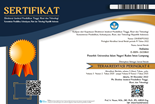Hubungan Antara Harapan Dengan Quarter Life Crisis Pada Mahasiswa Yang Mengalami Toxic Relationship
Abstract
Quarter life crisis is an emotional crisis experienced by individuals who are in the transition phase from adolescence to early adulthood (emerging adulthood). Students as individuals in their early adulthood need to have a solution in order to properly deal with this quarter life crisis period. Hope can reduce distress and foster a positive effect. The purpose of this study was to determine the relationship between hope and quarter life crisis in students who experience toxic relationships. The population in this study were students of the State Islamic University of Raden Intan Lampung. The sampling technique used is purposive sampling. The sample in this study amounted to 92 respondents. The measuring tools used are the quarter life crisis scale and the expectation scale. The analysis technique used is product moment correlation with the help of IBM SPSS ver 25 software for windows. The results showed that the majority of students were in the moderate category of quarter life crisis where women were higher than men. The expectation variable shows that the expectations that students have are mostly in the moderate category, both are in the same category. The results of the analysis show that expectations have a significant negative effect on the quarter life crisis (R= -0.431, R Square= 0.185, p < 0.01), which means that the higher the expectation, the lower the quarter life crisis experienced. And conversely, the lower the expectation, the higher the quarter life crisis experienced. Judging from the value of R Square, the expectation has an effect of 18.5% on the quarter life crisis, and the other 81.5% is influenced by other variables outside the study.
Key Word: Hope, Quarter Life Crisis, Toxic Relationship
Full Text:
PDFReferences
Arnett, J. J. (2014). Emerging adulthood; the winding road from the late teens through the twenties (II). Oxford University Press.
Atwood, J. D., & Scholtz, Æ. C. (2008). The Quarter-life Time Period : An Age of Indulgence , Crisis or Both ? 233–250. https://doi.org/10.1007/s10591-008-9066-2
Azwar, S. (2019). Penyusunan skala psikologi (II). Pustaka Pelajar.
Dickerson, V. C. (2004). Young women struggling for an identity. Family Process, 43(3), 337– 348. https://doi.org/10.1111/j.1545-5300.2004.00026.x
Effendy, N. (2019). Pendekatan psikologi positif pada toxic relationship (Dipresentasikan dalam seminar mahasiswa psikologi UNY, 20 Desember 2019). Website UNY. https://www.uny.ac.id/berita/pendekatan-psikologi-positif-pada-toxic-relationship
Hurlock, E. B. (1991). Psikologi perkembangan (V). Penerbit Erlangga.
Julianto, V., Cahayani, R. A., Sukmawati, S., & Aji, E. S. R. (2020). Hubungan antara Harapan dan Harga Diri Terhadap Kebahagiaan pada Orang yang Mengalami Toxic Relationship dengan Kesehatan Psikologis. Jurnal Psikologi Integratif, 8(1), 103. https://doi.org/10.14421/jpsi.v8i1.2016
Komnas Perempuan. (2021). CATAHU 2020 Komnas Perempuan: Lembar Fakta dan Poin Kunci (5 Maret 2021). Komnasperempuan.Go.Id. https://komnasperempuan.go.id/siaran- pers-detail/catahu-2020-komnas-perempuan-lembar-fakta-dan-poin-kunci-5-maret-2021
Murphy, M. (2011). Emerging adulthood in Ireland: Is the quarter-life crisis a common experience? Thesis, September, 1–44. https://pdfs.semanticscholar.org/0f75/a32d8463a5b30b4c5c435219805e33a73eeb.pdf
Mutiara, Y. (2018). Quarter life crisis mahasiswa BKI tingkat akhir. Skripsi, 1–28. https://www.uam.es/gruposinv/meva/publicaciones jesus/capitulos_espanyol_jesus/2005_motivacion para el aprendizaje Perspectiva alumnos.pdf%0Ahttps://www.researchgate.net/profile/Juan_Aparicio7/publication/253571 379_Los_estudios_sobre_el_cambio_conceptual_
Nash, R. J., & Murray, M. C. (2010). Helping college students find purpose: The campus guide
to meaning-making. Jossey Bass. https://doi.org/10.1353/csd.2011.0049
Putri, Y. Z. (2012). Esteem Pada Perempuan Dewasa Muda ( the Relationship Between Dating Violence and Self Esteem on Young Women ). 1955, 1–20.
Robbins, A. (2004). Conquering your quarterlife crisis: advice from twentysomethings who have been there and survived (1st ed.). The Berkley Publishing Group. https://books.google.co.mz/books?id=6JUAbTHK5QEC&printsec=frontcover&hl=id#v=o nepage&q&f=false
Robbins, A., & Wilner, A. (2001). Quarterlife crisis: The Unique Challenges Of Life In Your Twenties. Tarcher Penguin. https://www.google.co.id/books/edition/Quarterlife_Crisis/0o2ams7ShwsC?hl=id&gbpv= 1&dq=Quarterlife+Crisis:+The+Unique+Challenges+of+Life+in+Your+Twenties&printse c=frontcover
Robinson, O. (2001). How to turn your quarter-life crisis into quarter-life catalyst. Tarcher Penguin.
Robinson, O. C. (2018). A Longitudinal Mixed-Methods Case Study of Quarter-Life Crisis During the Post-university Transition: Locked-Out and Locked-In Forms in Combination. Emerging Adulthood, 7(3), 167–179. https://doi.org/10.1177/2167696818764144
Robinson, O. C., & Wright, G. R. T. (2013). The prevalence, types and perceived outcomes of crisis episodes in early adulthood and midlife: A structured retrospective-autobiographical study. International Journal of Behavioral Development, 37(5), 407–416. https://doi.org/10.1177/0165025413492464
Robinson, O. C., Wright, G. R. T., & Smith, J. A. (2013). The Holistic Phase Model of Early Adult Crisis. Journal of Adult Development, 20(1), 27–37. https://doi.org/10.1007/s10804- 013-9153-y
Snyder, C. R. (2000). Handbook of hope. Academic Press. https://books.google.co.id/books?hl=id&lr=&id=2KHRRaqqxTMC&oi=fnd&pg=PP2&dq
=Snyder,+C.+R.+(2000).+Handbook+of+Hope+Theory,+Measures.+San+Diego:+Acade mic+Press.&ots=4E0jUOYPAK&sig=f70dH0sIkaPGEKLoKJJVzP8VNeY&redir_esc=y# v=onepage&q=Snyder%2C C. R. (2000).
Sumartha, A. R. (2020). Pengaruh Trait Kepribadian Neuroticism Terhadap Quarter-Life Crisis Dimediasi Oleh Harapan Pada Mahasiswa Tingkat Akhir Universitas Islam Negeri Maulana Malik Ibrahim Malang. Skripsi, 17–28.
Wulandari, Y. P. (2019). Waspada Toxic Relationship Semakin Meningkat Setiap Tahunnya. Unair News. http://news.unair.ac.id/2019/12/26/waspada-toxic-relationship-semakin- meningkat-setiap-tahunnya/
Yayasanjari. (2020). Kekerasan dalam pacaran. Yayasanjari.Org. https://www.yayasanjari.org/kekerasan-dalam-pacaran/
DOI: http://dx.doi.org/10.24042/ajp.v5i1.13985
Refbacks
- There are currently no refbacks.
Copyright (c) 2022 ANFUSINA: Journal of Psychology













